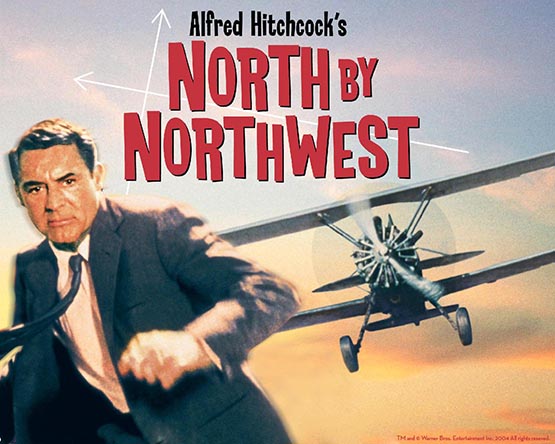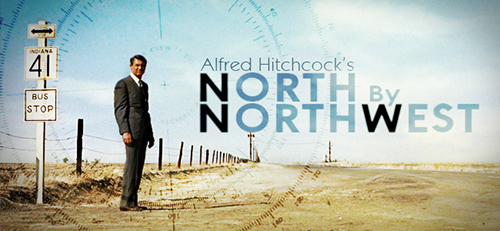This session
is dedicated to understanding the way that films tell stories but you
may also like to turn to illustrative images that show some influence
of the visual conventions of cinematography.
North
by Northwest
Sequence Analysis of the Chase in the Cornfield
Directed by Alfred Hitchcock, 1959
Photographed by Robert Burks,
Written by Ernest Lehmann
Music by Bernard Herrmann
Cary Grant is Roger Thornhill, Eve Marie Saint is Eve Kendall.
Roger
Thornhill is an advertising man in New York. He doesn't know it but
the CIA are using him to flush out some spies (evidently Communist).
Eve Kendall has been hired by the spies to lure him to a deserted spot
where he can be murdered.
Our analysis of the film encourages debate on;
establishing a credible space for the unfolding of narrative
orientation of action in a landscape
use of gesture and expression as indications of intent/anticipation
Now get your copy of the film and find the sequence where Thornhill
and Kendall meet before Thornhill takes the bus to meet Kaplan.
The SEQUENCE; timing listed first, in rolling minutes and seconds
1.1 Eve has just received instructions from a fellow spy ( a few phone
booths away). She tells Roger where he can meet the mysterious Mr.
Kaplan. They have shared the train journey out of New York and Roger
wants to see her again. She begins to feel guilty for using their
relationship to ensnare him
3.08 Roger gets off the bus and waits for his contact. No music or
dialogue.
6.22 Roger talks to man standing opposite who, it turns out, is waiting
for a bus. The man draws Roger's attention to a cropspraying aircraft
who it appears is spraying where there are no crops.
6.52 The bus leaves and Roger is alone.
7.40 The aircraft flies towards, then at Roger. On the second attack
he is shot at. At a third he runs through the bullets and hides in
a cornfield. The plane dusts that patch of corn and drives him out.He
sees a fuel lorry coming down the road and is nearly run over in an
attempt to stop it to get away. The pilot of the plane loses control
and crashes into the lorry. The drivers and Roger escape the blaze
and Roger makes his getaway in a van parked by one of the spectators.
 STILLS OF THE SEQUENCE STILLS OF THE SEQUENCE
 STORYBOARD STORYBOARD
Of North by Northwest, from Hitchcock by
Truffaut ,Paladin London 1986.
Truffaut,
"....all of the shots are of equal duration."
Hitchcock,"
Here you're not dealing with time but with space. The length of the
shots was to indicate the various distances that a man had to run
for cover, and more than that, that there was no cover to run to.
This kind of scene can't be wholly subjective because it would go
by in a flash. It's necessary to show the approaching plane, even
before Cary Grant spots it, because if the shot is too fast, the plane
is in and out of the frame too quickly for the viewer to realise what
is happening.... I tell you how the idea came about. I found I was
faced with the old cliche situation : the man who is put on the spot,
probably to be shot. Now, how is this usually done ? A victim standing
in a pool of light under the street lamp. The cobbles are 'washed
with the recent rain'. A closeup of a black cat slinking along against
the wall of a house. A shot of a window with a furtive face pulling
back the curtain to look out. The slow approach of a black automobile,
etc. etc. Now, what was the antithesis of a scene like this ? No darkness,
no pool of light, no mysterious figures in windows. Just nothing.
Just bright sunshine and a blank, open countryside with barely a house
or tree in which any lurking menaces could hide."
compare the scene with its possible source,
John
Buchan's novel The Thirty Nine Steps ,
"Just then I heard a noise in the sky, and lo and behold
there was that infernal aeroplane, flying low, about a dozen miles
to the south and rapidly coming towards me. I had the sense to
remember that on a bare moor I was at the aeroplane's mercy, and
that my only chance was to get to the leafy cover of the valley..
Down I went like blue lightning, screwing my head round whenever
I dared, to watch that damned flying machine.... It was flying
high, but as I looked it dropped several hundred feet and began
to circle around.... just as a hawk wheels before it pounces.
Now it was flying very low.... Suddenly it began to rise in swift
whorls and the next I knew it was speeding eastwards again....
My enemies had located me..... There was not cover in the whole
place to hide a rat..... It seemed to suffocate me. The free moorlands
were prison walls and the keen hill air was the breath of a dungeon."

EXERCISE; Now prepare a map of the narrative in the
landscape
1. in map form
2. in your own diagrammatic way
to include as much information as you can in a clear way.
|



